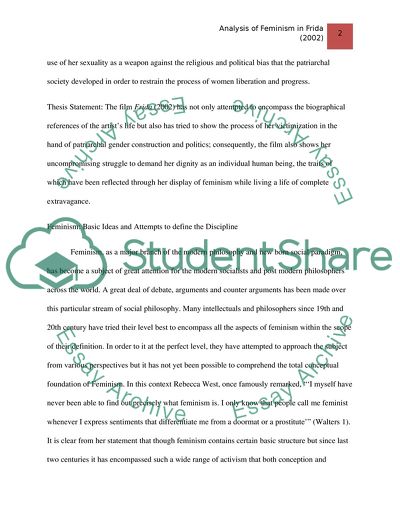Cite this document
(Feminism, Construction and Politics of Gender in the Movie Frida Research Paper, n.d.)
Feminism, Construction and Politics of Gender in the Movie Frida Research Paper. Retrieved from https://studentshare.org/gender-sexual-studies/1745805-close-analysis-of-feminism-construction-and-politics-of-gender-in-the-movie-frida2002-how-does-the-movie-frida2002-display-feminism-in-her-extravagant-life-through-her-sexuality-religion-and-politics
Feminism, Construction and Politics of Gender in the Movie Frida Research Paper. Retrieved from https://studentshare.org/gender-sexual-studies/1745805-close-analysis-of-feminism-construction-and-politics-of-gender-in-the-movie-frida2002-how-does-the-movie-frida2002-display-feminism-in-her-extravagant-life-through-her-sexuality-religion-and-politics
(Feminism, Construction and Politics of Gender in the Movie Frida Research Paper)
Feminism, Construction and Politics of Gender in the Movie Frida Research Paper. https://studentshare.org/gender-sexual-studies/1745805-close-analysis-of-feminism-construction-and-politics-of-gender-in-the-movie-frida2002-how-does-the-movie-frida2002-display-feminism-in-her-extravagant-life-through-her-sexuality-religion-and-politics.
Feminism, Construction and Politics of Gender in the Movie Frida Research Paper. https://studentshare.org/gender-sexual-studies/1745805-close-analysis-of-feminism-construction-and-politics-of-gender-in-the-movie-frida2002-how-does-the-movie-frida2002-display-feminism-in-her-extravagant-life-through-her-sexuality-religion-and-politics.
“Feminism, Construction and Politics of Gender in the Movie Frida Research Paper”, n.d. https://studentshare.org/gender-sexual-studies/1745805-close-analysis-of-feminism-construction-and-politics-of-gender-in-the-movie-frida2002-how-does-the-movie-frida2002-display-feminism-in-her-extravagant-life-through-her-sexuality-religion-and-politics.


